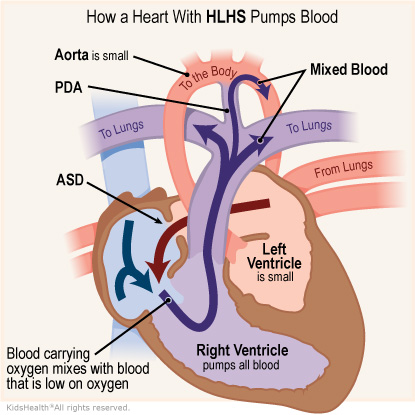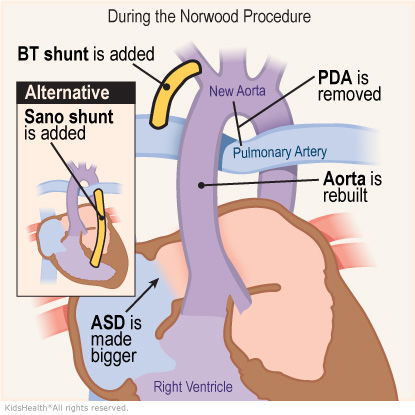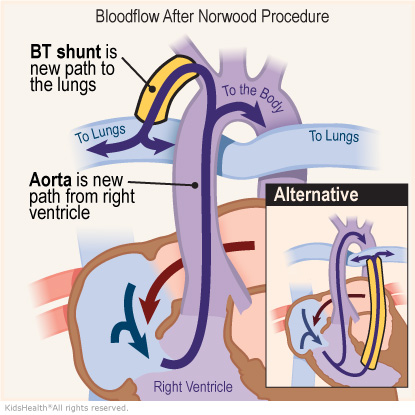The Norwood Procedure
Article Translations: (Spanish)
What Is the Norwood Procedure?
The Norwood procedure is a type of open-heart surgery for babies born with hypoplastic left heart syndrome. It is usually done in the first few weeks of life.
Why Does a Baby Need the Norwood Procedure?
Babies born with hypoplastic left heart syndrome need the Norwood procedure because their left ventricle and aorta are too small to pump blood to the body. The Norwood procedure lets the right ventricle pump blood to the body (usually it only pumps blood to the lungs).

What Happens During the Norwood Procedure?
During the Norwood procedure, the surgeon will:
- Build a new, larger aorta. The bottom part of the pulmonary artery (which normally goes from the right ventricle to the lungs) is joined with the aorta. This new, bigger aorta now goes from the right ventricle to the body.
- Create a shunt (path) to get blood to the lungs. Because the pulmonary artery now goes from the right ventricle to the body, a shunt is needed to take blood to the lungs. The surgeon will use one of these shunts:
- a Blaylock-Taussig-Thomas shunt, which moves blood from (and through) the aorta to the lungs.
- a Sano shunt, which moves blood from the right ventricle to the pulmonary artery. From the pulmonary artery, the blood goes into the lungs.
- Close the patent ductus arteriosus (PDA). Until now, the baby needed the PDA to stay open so blood could flow from the right ventricle to the body. Now that the right ventricle can pump more blood through the new, bigger aorta, the PDA isn't needed and can be closed.
- Make the atrial septal defect (ASD) bigger. This lets more blood with oxygen get back to the right ventricle so it can be pumped out to the body.

What Happens After the Norwood Procedure?
Babies who have the Norwood procedure usually spend 3 to 4 weeks in the hospital to recover. They get-around-the-clock care and monitoring. They also get medicines to help the heart and improve blood flow. They will keep taking some of these medicines at home.
During this time, the care team teaches parents how to care for their baby at home. Babies usually can go home when they are feeding well, growing well, and gaining weight.
Children with hypoplastic left heart syndrome will need at least two more surgeries, the Glenn procedure (around age 3–6 months) and the Fontan procedure (around age 18–36 months).

How Can Parents Help?
At home with your baby, follow the care team’s instructions about:
- giving any medicines
- feeding your baby
- checking your baby’s weight
- checking oxygen levels with a pulse-oximeter
- going to follow-up doctor visits
When Should I Call the Doctor?
Call the care team right away if your baby:
- is not eating
- is vomiting
- seems to be breathing fast or struggling to breath
- has oxygen levels that are higher or lower than usual
- seems very irritable
- just doesn't seem quite right
What Else Should I Know?
Caring for a child after heart surgery can be overwhelming for any family. But you’re not alone. The doctors, nurses, social workers, and other members of the care team are there to help you and your child.
It can help to find a support group for parents whose kids have a serious heart condition. Ask the care team for recommendations. You also can find support and more information online at:
Note: All information is for educational purposes only. For specific medical advice, diagnoses, and treatment, consult your doctor.
© 1995-2024 KidsHealth ® All rights reserved. Images provided by iStock, Getty Images, Corbis, Veer, Science Photo Library, Science Source Images, Shutterstock, and Clipart.com

